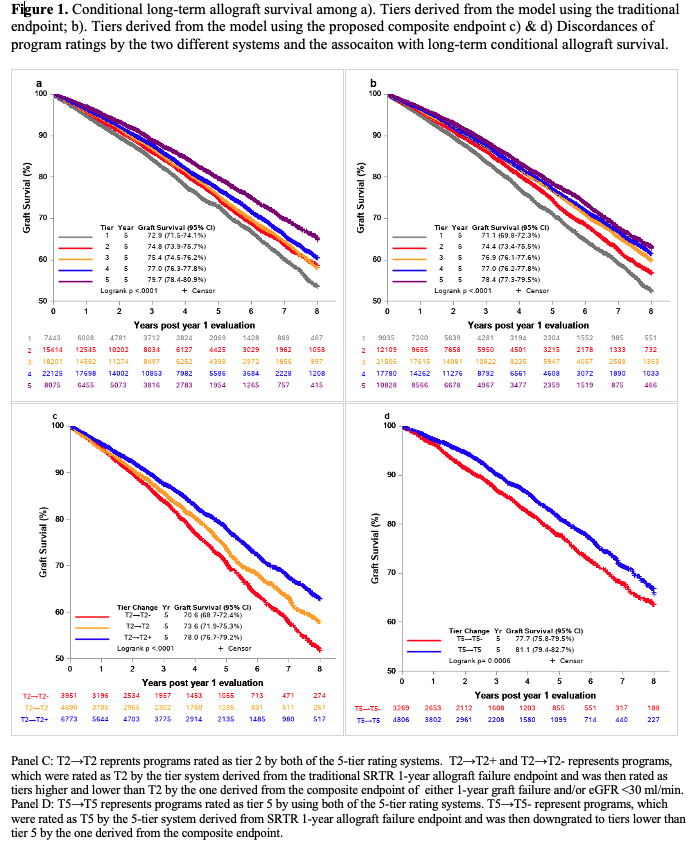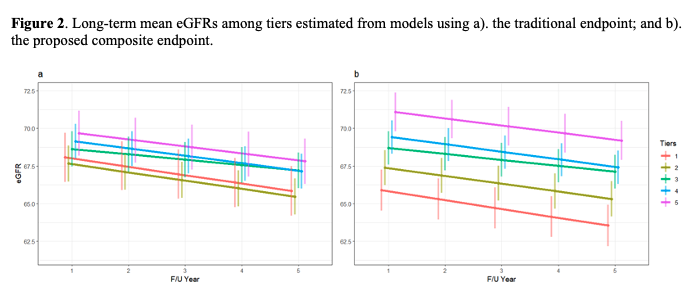A Composite Endpoint to Improve Upon the Srtr 5-Tier Rating System
1Yale School of Medicine, New Haven, CT, 2Yale School of Public Health, New Haven, CT, 3UNOS, Richmond, VA
Meeting: 2022 American Transplant Congress
Abstract number: 262
Keywords: Kidney, Kidney transplantation, Monitoring, Public policy
Topic: Clinical Science » Public Policy » 21 - Non-Organ Specific: Public Policy & Allocation
Session Information
Session Name: Non-Organ Specific: Public Policy & Allocation
Session Type: Rapid Fire Oral Abstract
Date: Monday, June 6, 2022
Session Time: 3:30pm-5:00pm
 Presentation Time: 3:40pm-3:50pm
Presentation Time: 3:40pm-3:50pm
Location: Hynes Room 311
*Purpose: Kidney transplant program performance in the US is monitored with outcome metrics used by regulatory agencies to assess provider quality and by patients to make decisions about their care. With few failure events per program and increasing homogeneity in program outcomes, quantifying meaningful differences in program performance based on 1-year survival rates has become challenging. This study explores whether the traditional endpoint of 1-year graft survival can be improved by incorporating the recipients’ estimated renal function (eGFR < 30 ml/min) into a composite endpoint.
*Methods: SRTR data from 1/1/2008-12/31/2018 was divided into a training and validation set. SRTR tiers were recreated using the traditional and composite endpoints. The conditional 5-year graft survival and 5-year eGFR were then assessed using each approach.
*Results: The composite endpoint generated tiers that better discriminated between the long-term performance of transplant programs compared to the current approach. The conditional graft survival was significantly different among tiers of both 5-tier systems p<0.0001 Fig1. The 5-year conditional graft survival were 72.9%, 74.8%, 75.4%, 77.0% and 79.7% tier 1-5 with the traditional endpoint model (inset table Fig1a) and were 71.1%, 74.4%, 76.9%, 77.0% and 78.4% for tier 1-5 for the composite endpoint model (inset table Fig1b). Fig1c and 1d show examples of the changes in longterm graft survival between programs that move up or down in tier when evaluated with the composite endpoint. The trajectories of mean eGFR were more separated among tiers derived from composite endpoint vs traditional endpoint Fig2. Using the 5-tier system derived from the composite endpoint, programs in Tier 3 (P<.0001), 4 (P<.0001) and 5 (P<.0001) had significantly higher mean eGFRs at 5 years compared to programs in Tier 1.
*Conclusions: An endpoint comprised of either 1-year graft failure and/or eGFR less than 30 ml/min may improve the ability of the SRTR 5 tier system to rank kidney transplant programs and provide patients with better information to make decisions by 1. better discrimination between SRTR tiers 2. better prediction of long-term graft survival 3. better prediction of long-term eGFR.
To cite this abstract in AMA style:
Formica R, Wang K, Deng Y, Stewart D. A Composite Endpoint to Improve Upon the Srtr 5-Tier Rating System [abstract]. Am J Transplant. 2022; 22 (suppl 3). https://atcmeetingabstracts.com/abstract/a-composite-endpoint-to-improve-upon-the-srtr-5-tier-rating-system/. Accessed December 15, 2025.« Back to 2022 American Transplant Congress


